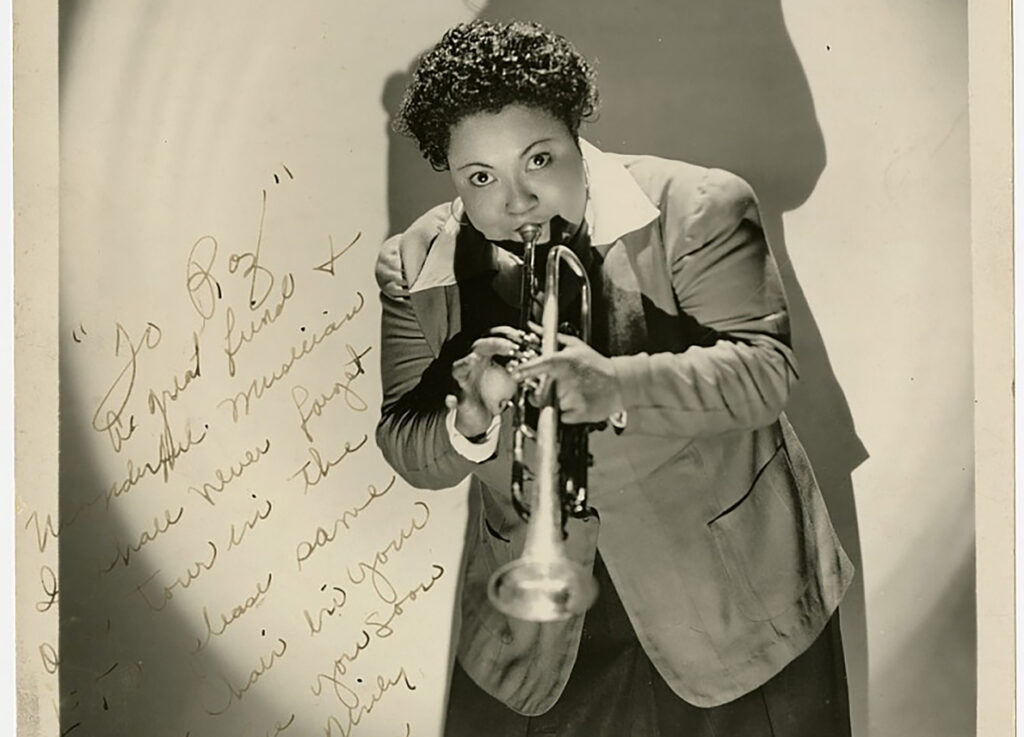There’s no argument about whether Tiny Davis could play at an elite level. The jazz trumpeter and vocalist was labeled the “female Louis Armstrong.” As a member of the International Sweethearts of Rhythm, an all-woman big band in the era of the Second World War, she went on to tour and record with her own band, Hell Divers, and co-owned a lesbian bar in 1950s Chicago alongside her partner, Ruby Lucas.
Davis is known as a member of the Chicago jazz scene—because while she refined her chops in KC, she was thrown out of the city’s jazz scene for being a lesbian. Few here uttered a word of her after that, which is why Pride month is a good time to tell her story again.
Tiny arrived on the KC scene in the 1930s alongside her newlywed husband, Clarence Davis. While Clarence, also a trumpet player, moved to KC to pursue his career, Tiny quickly found success in the booming jazz hub as well. In addition to playing with a variety of dance bands, she joined the Harlem Playgirls, a touring jazz band of all Black women.
It didn’t take long for many of the Harlem Playgirls, including Davis, to receive a better offer of joining the International Sweethearts of Rhythm, a larger, more established all-woman big band with more touring and recording potential. For the next six years, Davis was a member of the Sweethearts, even going on a USO tour across military bases in Europe.
Throughout her years with the Sweethearts, Davis continued to call KC her home base in between tours, in addition to playing the Sweethearts’ annual Kansas City show during Easter. It was at one of these Easter shows where Tiny was introduced to Ruby Lucas, a multi-talented bassist, pianist and drummer. While the specifics of the timeline are unknown, we do know that around the time she began touring with the Sweethearts, Tiny ultimately left her husband and fell for Ruby.

Soon after Tiny met Ruby, their time in Kansas City came to a halt. “We got ran out of town,” said Ruby in a 1988 documentary entitled Tiny and Ruby: Hell Divin’ Women. So they packed up their things and headed to Chicago, and Tiny started her newest group, Tiny Davis and the Hell Divers, with Ruby on bass.
But like many other women, Tiny and Ruby struggled to find work after WWII, as female entertainers were seen as wartime novelties—a phenomenon probably best known from A League of Their Own.
To guarantee consistent work for themselves, Tiny and Ruby opened up a not-so-discreetly named gay bar and jazz club on the Southside of Chicago: Tiny and Ruby’s Gay Spot. For the next decade, the club was a pillar of Chicago’s queer community until the club was sold and demolished in 1958. Tiny and Ruby continued to play on the Chicago scene until Tiny’s arthritis progressed. While Tiny Davis was an important figure in Chicago’s jazz scene, as well as the city’s LGBTQ+ history, she is an equally important voice in Kansas City’s history worth remembering and amplifying. Preserving the story and legacy of Tiny, a marginalized woman who faced intersectional discrimination throughout her entire life, was not made a priority until the end of her life. While documentation of her is limited, the witty and often bawdy Tiny Davis can be remembered through a thirty-minute documentary, Tiny and Ruby: Hell Divin’ Women, intimately captured in Tiny and Ruby’s Chicago home in 1988.






